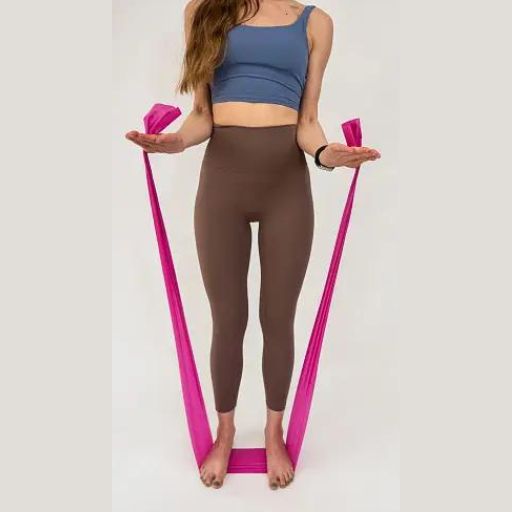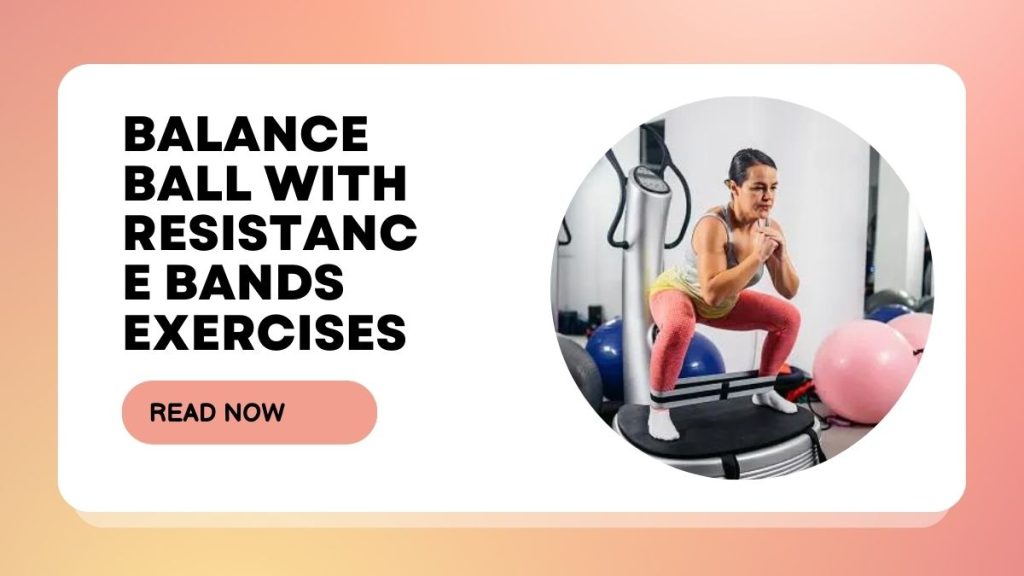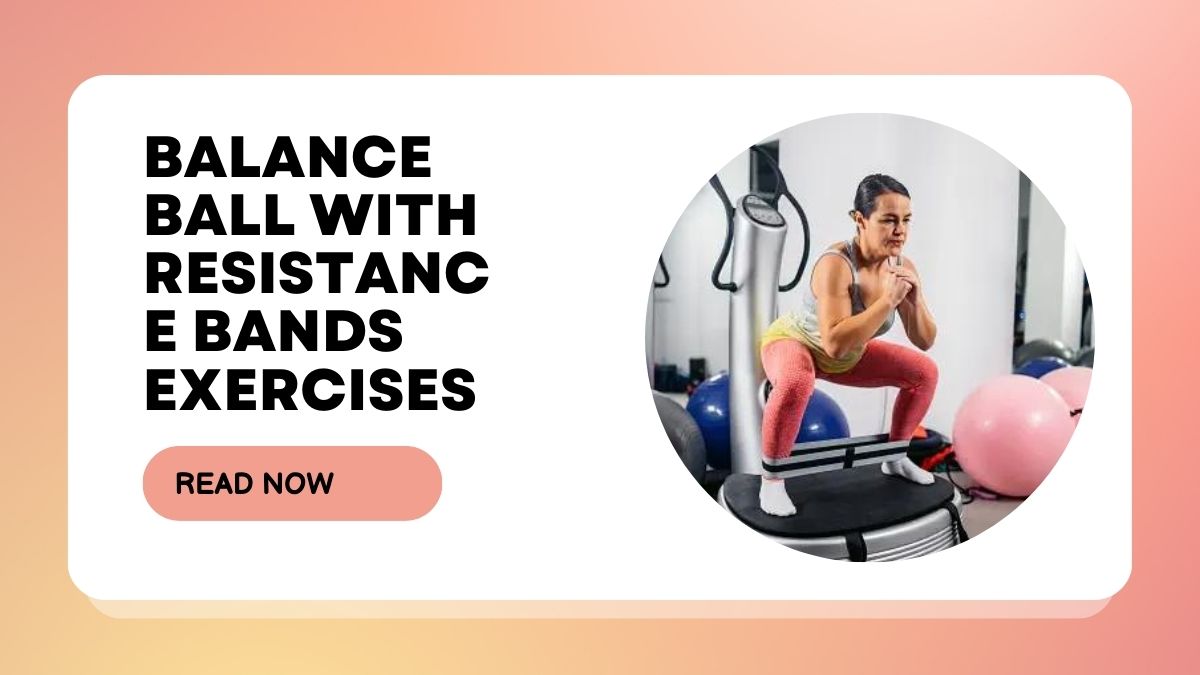Balance Ball With Resistance Bands Exercises [In-depth Review]
The balance ball with resistance bands is a therapy choice for back pain that can prevent or reduce episodes of low back pain. It stabilizes the spine’s bones by strengthening and developing the central body muscles.
What is the balance ball with resistance bands exercises? A balance ball with resistance bands is an exercise object used for full-body collaboration and adaptability for workouts, recovery, and stretching.

The balance ball with resistance bands provides instability, which enables the body to auto-sustain balance. Muscles accumulate strength in their abdominal and back regions over time. It also employs proprioception to improve equilibrium and stability by assessing one’s position in place.
Read more: Shoulder exercise at home for pain 2024
Benefits of Exercise Balls
Balance ball with resistance bands might help gym-goers get more out of their exercises in less time. Your core muscles must work harder to stabilize and balance on a balance ball with resistance bands.
You may get a better workout by moving your chest press, shoulder press, and crunches on a balance ball. Without doing many sit-ups, you’ll exercise your core while working other muscles.
Balance Ball With Resistance Bands Exercises
Two training gadgets can help build muscle, provide home gym benefits, and sculpt strong contours. A basic bicep curl develops arms, abs, waist, back, and legs. Movement in arcs and circles with bands mimics high-tech gym equipment, tones front, back, and sides of muscles. Deflectable bands and balls are ideal travel companions for a full-body workout.
Band and ball fundamentals
Most sports shops sell this equipment for under $40.
Bands: Choose a box with 5 feet of gentle, medium, and powerful resistance bands. Hold the band long enough to create your final two or three repetitions challenging. Wrap the band ends lightly over your hands for added resistance if it’s too long. To maximize resistance and avoid the band from popping back, go gently through each exercise.
Balls: Choose a size that lets you sit flat-footed and parallel-thighed. A 65-centimeter ball suits most. For those under 5’5″, try a 55-centimeter ball; those over 5’11” should use a 75-centimeter ball. Avoid balance bal if you’ve never utilized one. Balls with more air and firmness are difficult to balance.
Add these 5 balancing balls with resistance band exercises to your everyday workout, from easy to difficult.
1. 30 Minutes Sit
Staying balanced on an balance ball needs slight but consistent core muscle activity.
Start a 30-minute seated workout by sitting on a balance ball with your feet erect and hip-width spread.
To activate your center of gravity and remain on the ball, gently tighten your abdominal muscles.
1. Maintain an erect stance.
2. Start with 10 to 30 minutes.
3. Learners balance better on a slightly deflated balance ball .
2. Ball-Marching
Increase your involvement with the ball moving.
Lay on the balance ball with your feet straight and hip-width apart to do this exercise.
1. Exercise ball-sitting women’s march.
2. Maintain your toes on flat surfaces and elevate one heel with an erect spine and arms on the knees. Lift your full foot off the floor to increase the effect of this exercise.
3. Hold for a while and lower your foot.
Switch sides and repeat this workoutTen to fifteen minutes
3. Wall-Assisted Ball Squat
This exercise builds abdominal power and provides supported lifting.Balance ball squats include standing with your back against a wall and placing the workout ball between your lower back and the wall.
Set your feet approximately shoulder-width apart in the direction towards you. Put your hands on your hips and push your back onto the ball.
- Pivot at your hips and softly bend your knees in order to squat.
- Maintain your feet level and your weight on the heels as you squat.
- You should roll the puck up as you descend.
- Pause at the deepest section of the squat for a few moments, then gently rise.
Perform the exercise 5 times. Add repetitions or hold longer at the lowest point of the squat for a more difficult workout.
4. Ball Sit-Ups Are Harder
The Swiss ball makes sit-ups more dynamic since it takes greater balance to work the abdominal muscles.
Sit on the balance ball with your feet flat on the surface and your hips apart to execute dynamic ball sit-ups.
- Fold both arms over to the sides and softly lean back 45°, twisting at your hips and coming up on your toes.
- Keep this posture for a moment.
- You can sit up without raising your feet by using the muscles in your belly.
You have to practice this exercise five times. Increase reps or hold longer while falling back for a more advanced practice.

5. Ball-Leg Raises
The ball leg-lift movement, like the preceding one, boosts leg-lift force. Sit on the floor with the activity ball behind you to complete ball left-lifts.
- Slide back until your head and shoulders lay on the ball and it’s between the tops of your shoulder pads.
- Hold your hands behind your head while keeping your feet flat.
- Lift your back and hips gently until your spine is flat to the ground and your knees at 90°.
- Raise one leg off the floor and extend it to body height.
Continue for 10 seconds, then drop the leg.
Advice For A risk-Free Workout
- Make sure you give yourself at least one day off in between exercises.
- Exercise should be avoided if you are suffering discomfort.
- Try to keep a steady pace and avoid overextending yourself.
- If you are just beginning to engage in physical activity or if you have been inactive for a short period of time, it may be beneficial to examine this “to-do” list that was provided by an expert.
These are merely broad pieces of information. You should consult with a skilled medical practitioner who is familiar with your medical history in order to get thorough or specific personal advice.
FAQs on Balance Ball With Resistance Bands Exercises
Q: How are resistance bands used?
A: These rubber or textile bands may be used to increase resistance during workouts. By making the motions more difficult, more muscles are engaged, and strength is subsequently increased. The bands come in various shapes and sizes, and you may wrap them over your legs or arms.
Q: Can you use resistance bands every day?
A: Pick a level of strength that lets you do 10–15 reps while maintaining proper form, alignment, and control. Strength training should be done two or three times a week, but not on a single day.
Q: Do resistance bands burn fat?
A: By enhancing lean body mass and hence raising metabolic rates, elastic bands may aid in fat loss. Strength training using resistance bands is an effective way to burn fat and develop muscle.
Read More: Best Workout Pick Up Lines 2024
Conclusion
Balance ball with resistance bands exercises improve balance and core power. It’s excellent for stability, strength, and agility and is customizable to your health plans.
We hope that we were able to explain the balance ball with strength band movements. But if you have any trouble doing it right, please watch the video that’s attached to this piece or leave a question in the comments.
